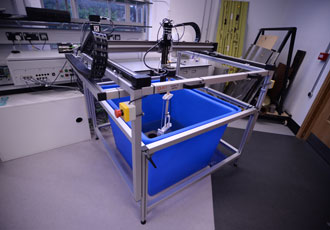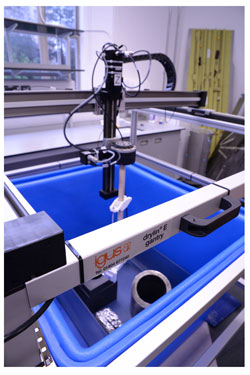Linear systems aid the Fukushima clean-up with a safe distance

Back in March 2011, located on the Pacific coast ofFukushima Prefecture in Japan, the Fukushima Daiichi Nuclear Power Plant was severely damaged by the Tōhoku earthquake and ensuing tsunami. Throughout this chain of events three nuclear reactors were without suitable cooling and underwent a catastrophic meltdown. The clean-up and decommissioning has required thousands of scientists across the world to invent, develop and deliver new or improved techniques for nuclear debris removal and site remediation.
Part of the planned decommission process requires the once molten nuclear fuel to be removed. However, there is currently very little knowledge about the location and makeup of the fuel debris. The high radiation environments within the reactor buildings have made optical camera systems inoperable.
A promising method of visualising and characterising the fuel debris is to use acoustic imaging sonar systems within the reactor buildings. This is because sonar systems are very tolerant to radiation and offer the ability to not only image the shape of fuel debris but also to look inside it.
A decommissioning programme can only be advanced once the full nature of the fuel debris is known. “We needed to design and develop a large scanning system, which would allow us to position sonar probes and image simulated uranium fuel debris, nuclear reactor core components and nuclear grade pipework,” said Dr. Rob Malkin a Senior Research Associate in Non-Destructive Evaluation in the Department of Mechanical Engineering at the University of Bristol. “This scanning system, which employs the drylin E linear robot gantry system from igus, will allow us to develop new imaging methodologies of nuclear fuel in a safe and adaptable environment.”
“During the commission stages of the gantry system, Adam Sanjurgo at igus provided us with technical support,” continued Dr. Malkin. “Working in close collaboration, we identified a number of critical aspects of its performance, which needed to be met. The priority was that the system is modular in design, this will enable us to adapt it as the nature of the situation in Fukushima changes. Importantly, we needed to be able to add additional motors and guides. Due to the sensitive nature of work conducted within the laboratory, where the scanning system is situated, the final system has to operate quietly. Contaminant risk also has to be minimised so as not to damage any of our highly sensitive (and expensive) equipment.”
Because the system will be operated remotely in a radioactive environment, maintenance needed to be minimal without compromising performance. The linear robot gantry system also needed to fit into a small space and the cable management simple to use and easily adaptable – this was very important as sensors will be added and removed regularly during the test phases. Positional accuracy of the system had to be within a millimetre, as ultrasonic measurements rely on accurate distance measurement. “Above all, the whole system had to be affordable and complemented by good support from the manufacturer as scanning systems are not our area of expertise,” explained Dr. Malkin. “The control system had to be designed and implemented by us. We have some very specific motion control requirements and wanted to create this in-house.”
“Once we identified the specifications for the linear robot gantry, we worked with Adam Sanjurgo to outline the whole system,” concluded Dr. Malkin. “We have a very robust gantry frame, which integrates the e-chain cable management system, drylin bearings, stepper motors, proximity switches and all cabling needed. Having had the whole system operational for about 6 months, each of our requirements has been met or exceeded. We are very happy with the system’s performance and it has already started to generate very useful data. Additionally, working with and modifying the whole system has been very easy, which for us as novices in motion control was very important.”
Similar articles
More from igus UK Limited
- From garage business to world leader: igus founders celebrate 90th birthday 22nd June 2021
- VOTW - Metal out plastic in! 10th June 2021
- igus robot works alongside agri-tech startup 18th May 2021
- Tribo-polymers increase machine service life and efficiency 10th May 2021












Write a comment
No comments